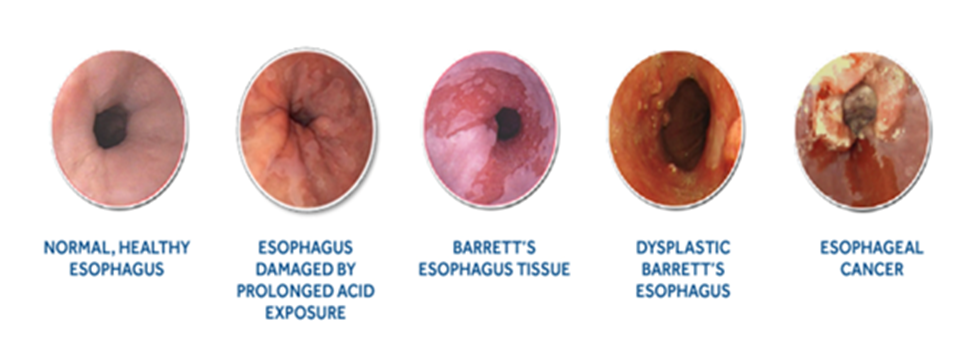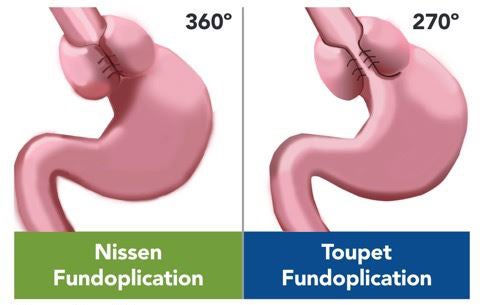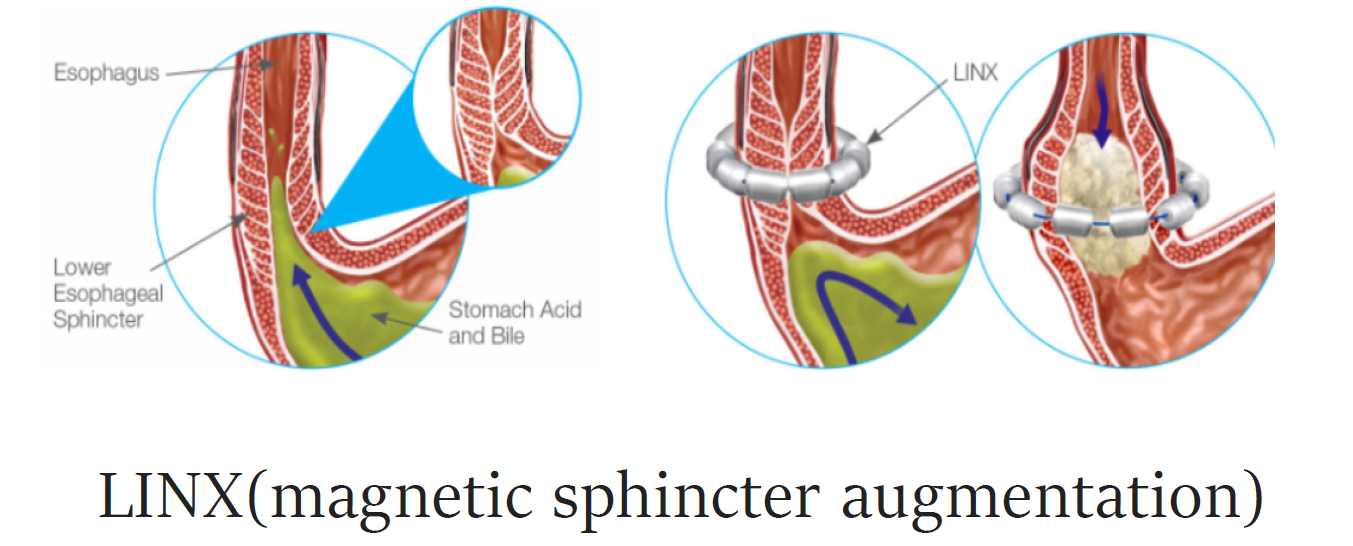Heartburn

Gastroesophageal reflux disease (GERD)
Reflux occurs when stomach acids and juices flow back up into the esophagus, causing discomfort known as heartburn. Frequent or chronic heartburn is known as gastroesophageal reflux disease, or GERD. GERD can also cause pain and swelling in your esophagus — this is known as esophagitis.
What causes GERD?
When you swallow food, it travels down the esophagus. Normally, there is a pressure zone that relaxes to allow food into the stomach and tightens to keep it there. With GERD, this pressure zone relaxes at inappropriate times, is weak or has been damaged by some other factor, allowing stomach contents to flow back up into the esophagus.
Risk factors include:
- Being overweight
- Consuming alcoholic, caffeinated or carbonated beverages
- Consuming foods like:
- Chocolate
- Citrus
- Onions
- Mint
- Tomato or other acidic foods
- Spicy foods
- Fried foods
- Eating large meals or eating right before bed
- Hiatal hernia
- Pregnancy
- Medications including aspirin and certain drugs for
- Asthma
- High blood pressure
- Allergies
- Depression
- Sleep disorders
- Pain
What are the symptoms of GERD?
The main symptom is ongoing heartburn, which can feel like burning, warmth, or pain behind the breastbone. You may also have a sour or bitter taste in your mouth. These symptoms often occur at night when you’re trying to sleep.
How is GERD diagnosed?
If you show frequent symptoms of GERD, your provider may recommend that you have tests done, which will be performed in their office or in the hospital. These tests can include:
Manometry: Performed in the office, this test determines whether the esophagus is contracting and relaxing properly. A catheter is inserted through the nose and down into the stomach to measure contractions and pressure. Once the catheter is inserted, the test takes only about 15 minutes.
EGD with Bravo insertion: Performed in the hospital, this test takes place under light sedation. A specialist will perform a gastric endoscopy and place a tiny sensor in your esophagus, which will stay for up to 96 hours, before naturally passing through your GI tract.
During that time, the capsule will measure acidity levels, and you’ll use a small recording device to document times of eating, drinking, lying down and sleeping — or whenever you feel reflux, regurgitation or pain. The measurements will allow your specialist to tailor the best treatment plan for you.
EndoFlip: If your specialist determines that surgery is necessary to treat your GERD, this tool will be used. While under anesthesia, this tiny balloon catheter is passed through the mouth, and into the esophagus and stomach to measure the pressures of your body. This allows surgeons to tailor the procedure specifically for you, leading to less postoperative discomfort during your recovery.
How is GERD treated?
The first line of defense is behavioral. This can mean dietary changes, adjusting your eating schedule or other changes to your daily habits — for example, eating several small meals throughout the day instead of three large ones.
We may also recommend or prescribe certain medications such as antacids (TUMS), H2 blockers (Pepcid) or proton pump inhibitors (PPIs, like omeprazole). PPIs, when taken long term, can have effects on your overall health. Talk to your primary care provider if you have been on PPIs long-term.
If your GERD persists or is not helped by changes to diet or medication, we may recommend surgery as a more permanent solution.
Long-term consequences — what happens if we don’t treat it?
Chronic reflux can cause a painful irritation called esophagitis. It can also cause changes in the lining of the esophagus, called Barrett’s esophagus, which is a precursor to esophageal cancer. That’s why it’s crucial that if you experience symptoms frequently, you discuss them with your provider and seek treatment as soon as possible.
In rare cases, severe reflux can cause hoarseness, permanent vocal changes, and even severe narrowing of the esophagus.

How can I reduce my GERD symptoms?
While more drastic treatment may be required to address underlying causes, there are things you can do to help reduce your symptoms and boost quality of life. Take your medications as directed, especially prescription medications. Eat small meals more frequently. Avoid common trigger foods like chocolate, mint, caffeine, alcohol, acidic foods and spicy foods. Wait two to three hours after eating before lying down or going to bed. Raising the head of your bed 6 to 8 inches can help to reduce nighttime reflux.
GERD surgery
Robotic Nissen/Toupet fundoplication
A Nissen fundoplication is a full wrap of the stomach around the esophagus, like a bun around a hot dog. This helps rebuild the pressure zone that keeps stomach acids from entering the esophagus. However, it can sometimes cause difficulty swallowing after surgery. This is where technology allows us to tailor the procedure specifically to your body.
A Toupet or “partial” fundoplication is a ¾ wrap of stomach around the esophagus. This is similar procedure as the Nissen fundoplication, in that it also controls reflux without difficulty swallowing immediately after surgery. Given that it is not a full wrap, it does not apply as much pressure.

Results of a robotic fundoplication
- Studies show quality of life significantly improves after surgery.
- GERD-related symptoms improve in a high percentage of patients.
- Most patients are able to stop taking acid-suppression medications.
- More than 90% of patients are satisfied with results.
- Most patients are discharged from the hospital the morning after their surgery and return to a normal lifestyle in two to four weeks.
- Surgery is typically covered by insurance.
Robotic LINX® system
The LINX procedure corrects a weak esophageal valve to prevent acid reflux from occurring. The device looks like a small, stretchy magnetic bracelet placed around the lower esophagus through small incisions in the abdomen.
LINX restores the lower esophageal sphincter (LES) barrier through dynamic augmentation. It is a flexible ring of small magnets placed around the LES robotically. The strength of the magnets helps the weak LES closed to prevent reflux. When patients swallow, LINX opens temporarily to allow food and liquid to pass into the stomach

Results of a robotic LINX system
Of the patients who undergo this procedure:
- 90 to 95 percent are able to stop taking medication completely.
- 5 to 10 percent rarely take medication
Robotic Gastric Bypass
Being overweight could cause or even worsen acid reflux. This also impacts recovery after surgery and can even make the reflux come back after a successful surgery. Depending on your situation, your specialist may suggest considering gastric bypass surgery to resolve your heartburn.
This surgery is a safe, well-known weight loss tool that also has fantastic results for the treatment of heartburn. It will disconnect the main source of acidity from your esophagus and allow it to heal. The surgery is also performed with minimally invasive techniques which allows for faster recovery, minimal time in the hospital and offers the benefit of resolving the heartburn for good. Losing weight will also improve and even cure other common health problems like high blood pressure, high cholesterol, diabetes, sleep apnea and arthritis.
To schedule a consultation and learn more, call us at 1-888-569-1000 for an appointment with an expert.